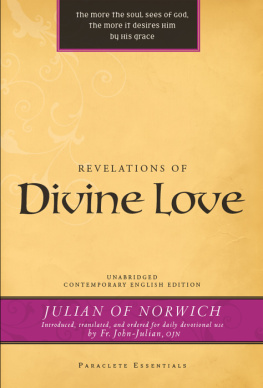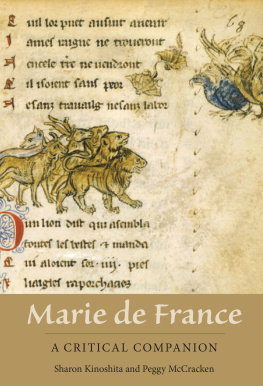
JULIAN OF NORWICH
a contemplative biography

AMY FRYKHOLM
a contemplative biography
JULIAN
of Norwich

Julian of Norwich: A Contemplative Biography
2011 First Paperback Printing
2010 First Hardcover Printing
Copyright 2010 by Amy Frykholm
ISBN 978-1-61261-097-9
The Library of Congress has catalogued the hardcover edition as follows: Frykholm, Amy Johnson, 1971
Julian of Norwich : a contemplative biography / Amy Frykholm.
p. cm.
Includes bibliographical references (p. ).
ISBN 978-1-55725-626-3
1. Julian, of Norwich, b. 1343. 2. Women mysticsEnglandBiography. I. Title.
BV5095.J84F79 2010
282.092--dc22
[B] 2010009417
10 9 8 7 6 5 4 3 2 1
All rights reserved. No portion of this book may be reproduced, stored in an electronic retrieval system, or transmitted in any form or by any meanselectronic, mechanical, photocopy, recording, or any otherexcept for brief quotations in printed reviews, without the prior permission of the publisher.
Published by Paraclete Press
Brewster, Massachusetts
www.paracletepress.com
Printed in the United States of America
This book is dedicated to my mother,
MICHELE JOHNSON,
who has faithfully modeled attention to the lowly and simple things.
Contents
 WINDOWS
WINDOWS 
Introduction

I N THE MIDST OF WHAT HISTORIAN BARBARA TUCHMAN has called the calamitous fourteenth centurymarked by war, famine, plague, and unrestone woman wrote a book. It was the first book composed by a woman in English and remains one of the greatest theological works in the English language. So little is known about this woman that even her nameJulian of Norwichis in question. Yet her achievement is extraordinary. Very few peoplemale or femaleat that time wrote anything in English. As the language of the common people, English was rarely used for literary purposes. But Julians achievement isnt just in having written a book in English, but in the nature of what she had to say.
Playfully and subtly maneuvering amid political dangers and social limitations, with open curiosity and dry humor, Julian took a heavy world of religious obligation and turned it on its head. In her book, which is both an account of visions she received and a book of spiritual direction and theological reflection, she wrote, The soul must perform two duties. One is that we reverently marvel. The other is that we humbly endure, ever taking pleasure in God. In Julians understanding, the right relationship between God and the soul was not primarily guilt for sin, but wonder, release, and unity. She wrote that the righteousness required of us was simply this: delight in Gods good world.
This delight travels a hard road through Julians writing, as it did through her life. To reach delight, Julian had to traverse the suffering she saw all around her and experienced herself, and then actively choose compassion. Eventually, she saw that God and the soul shared something so intimate that even sin could not disrupt itthe soul and God were one.
Perhaps even more strikingly, Julian saw herself, a laywoman, as representative of all Christians, and she believed that the visions she had received were meant for all. Her writing, of necessity, took on a prophetic tone as she tried to peer forward to a time when God would use her writing for his own honorable, marvelous, and plenteous work.
At last in our own day, Julians writings have reached a wide audience. Dozens of current translations, devotional books, and anthologies suggest that Julians words reach the present with striking urgency. We are hungry to understand this God whose love encloses us. We ache to understand that the soul is intricately oned both to the body and to God. We desire to act in the world as full creatures, wholly loved. Julian becomes, almost inexplicably, a teacher for our times. Yet we experience discomfort in confronting Julians suffering Christ. For contemporary readers, Julians declaration that at a young age she desired a bodily sickness coupled with her gory depictions of Christ bleeding on the cross are off-putting and impenetrable. This contradiction has made Julian both a welcome voice and a distant one. To overcome that distance, we must gain a better understanding of her life.

THE REVOLUTIONARY ACT OF REENVISIONING the relationship between God and the soul and then writing it down was done quietly, in solitude, on the far eastern coast of England in the river port city of Norwich. In her book, Julian writes that at the age of thirty, she became seriously illso ill that she and all of those around her thought she would die. In the midst of this mysterious illness, Christ appeared to her as in the passion of his crucifixion. And over the course of several hours, Christ revealed to her the mystery of his compassion.
During her visions and for decades afterward, Julian wrestled with understanding what she had seen. The God of her visions and the God of the church to which she was devoted contradicted each other, sometimes painfully. The church in Julians time was beginning to take violent measures to protect its power. By the time Julian took up a pen putting words to parchment, the church hierarchy had actively banned the use of English in religious contexts, except in sermons, confessions, and other practical matters. People were carried out of the city gates of Norwich and burnt if an English-language Bible was discovered in their homes.
In this context of fear, the crucified Jesus taught Julian that she was utterly safe in his love. Safety did not come from bowing to the forces of fear. Instead, it came from submitting oneself in love to the one who is love. As if reflecting on her precarious positionas a woman writing a religious book in EnglishJulian wrote that love itself kept her safe. And thus will I love, and thus do I love, and thus I am safe.
A sense of spiritual safety alone was not enough for a woman in the Middle Ages to undertake the writing of a book. She needed to seek solitude and relief from everyday burdens. One of the few things we know for certain about Julian is that in the middle of her life she went to live in an anchoragea small solitary cellnext to St. Julians church in Norwich, dedicating herself to prayer and dwelling next to the church until the end of her life. Perhaps she took her name from this church; perhaps the similarity is mere coincidence.
The majority of anchorites (coming from the Greek, meaning to withdraw) in Julians time were, like Julian, women from the Norfolk region of England. Traditionally, an anchorage was a small cellsometimes just one roomwith three windows. These windows were the sole openings for the anchoress onto the world. One window opened to the church, where an anchoress could hear the daily mass. Another window opened onto a servants quarters, through which daily life transpired. A third window opened onto a small porch, through which the anchoress received visitors.
Next page














 WINDOWS
WINDOWS 

